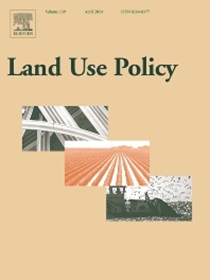Spatially explicit multi-objective optimization tool for green infrastructure planning based on InVEST and NSGA-II towards multifunctionality
IF 6
1区 社会学
Q1 ENVIRONMENTAL STUDIES
引用次数: 0
Abstract
The imperatives of sustainable urban development have propelled the prominence of green infrastructure (GI) as a viable solution. However, prevailing methodologies for GI planning often prioritize individual ecosystem services (ES) and lack spatially explicit guidance. This study presents a spatially explicit approach integrating the InVEST model and the Non-dominated Sorting Genetic Algorithm-II (NSGA-II) algorithm as a multi-objective spatial optimization tool for assisting decision-making in multifunctional GI planning. The spatially explicit InVEST model was used as a model to assess GI multifunctionality. To demonstrate the applicability of our proposed model, GI of the central area of Wuhu City are optimized with the aim of maximizing the 3 objectives of maximizing habitat quality, crop production, and runoff reduction, evaluated respectively by InVEST habitat quality model, crop production model, and urban flood risk mitigation model. The comparison of typical optimized GI planning schemes—including the compromise, habitat quality preference, runoff reduction preference, and crop production preference scenarios—with the current scenario demonstrates significant improvements in corresponding ES objective. Our findings suggest that increasing forest land, certain types of arable land, and green spaces may have a higher probability of enhancing the multifunctionality of the site. Allocating GI elements in highly built-up areas may efficiently enhance multifunctionality. Spatial analysis of optimal GI schemes reveals a preference for dispersing forest land and grassland, while aggregating agricultural GIs to enhance multifunctionality. Non-linear relationships are found between the ES pair of crop production and habitat quality, as well as runoff reduction and habitat quality. Identifying inflection points where synergies and trade-offs shift is essential for maximizing multifunctionality. Trade-off relationships between crop production & runoff reduction are identified. Our study highlights the importance of recognizing non-linear relationships between certain ES pairs in GI planning, particularly identifying inflection points where synergies and trade-offs shift. This research underscores the viability of our proposed model in facilitating informed decision-making pertaining to GI planning on a citywide scale, with a specific emphasis on achieving multifunctionality. By addressing the shortcomings of current approaches and integrating advanced optimization techniques, our model offers valuable insights for policymakers and practitioners involved in sustainable urban development and GI planning.
基于InVEST和NSGA-II的多功能化绿色基础设施规划空间明确多目标优化工具
可持续城市发展的必要性推动了绿色基础设施(GI)作为一种可行的解决方案的突出地位。然而,现行的地理标志规划方法往往优先考虑单个生态系统服务,缺乏明确的空间指导。本研究提出了一种空间显式方法,将InVEST模型与非支配排序遗传算法- ii (NSGA-II)算法相结合,作为辅助多功能地理标志规划决策的多目标空间优化工具。空间显式InVEST模型被用作评估GI多功能性的模型。为验证该模型的适用性,以芜湖市中心区域为研究对象,以最大化生境质量、最大化作物产量和最大化径流3个目标为目标,分别采用InVEST生境质量模型、作物产量模型和城市洪水风险缓解模型对其进行了优化。通过比较典型的地理标志优化规划方案(包括妥协方案、栖息地质量偏好方案、径流减少偏好方案和作物生产偏好方案)与当前方案的比较,可以发现相应的生态系统目标有显著改善。我们的研究结果表明,增加林地、某些类型的耕地和绿地可能更有可能增强场地的多功能。在高度建设的地区分配地理要素可以有效地增强多功能。最优地理标志方案的空间分析表明,地理标志方案倾向于分散林地和草地,而聚集农业地理标志以增强多功能性。作物产量ES对与生境质量、径流量ES对与生境质量存在非线性关系。确定协同作用和权衡转变的拐点对于最大限度地发挥多功能至关重要。作物产量与产量之间的权衡关系;确定了径流减少。我们的研究强调了在地理标志规划中认识到某些ES对之间的非线性关系的重要性,特别是识别协同效应和权衡转移的拐点。这项研究强调了我们提出的模型在促进与城市范围内地理标志规划相关的明智决策方面的可行性,特别强调了实现多功能。通过解决当前方法的不足并整合先进的优化技术,我们的模型为参与可持续城市发展和地理标志规划的决策者和实践者提供了宝贵的见解。
本文章由计算机程序翻译,如有差异,请以英文原文为准。
求助全文
约1分钟内获得全文
求助全文
来源期刊

Land Use Policy
ENVIRONMENTAL STUDIES-
CiteScore
13.70
自引率
8.50%
发文量
553
期刊介绍:
Land Use Policy is an international and interdisciplinary journal concerned with the social, economic, political, legal, physical and planning aspects of urban and rural land use.
Land Use Policy examines issues in geography, agriculture, forestry, irrigation, environmental conservation, housing, urban development and transport in both developed and developing countries through major refereed articles and shorter viewpoint pieces.
 求助内容:
求助内容: 应助结果提醒方式:
应助结果提醒方式:


